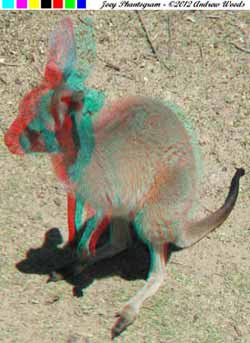New analysis yields improvements in a classic 3D imaging technique

Anaglyph 3D image of a joey used in part of<br>the research experiments. The color bars at<br>the top of the image are used to determine<br>the purity of the color printing process. Photo<br>credit: Andrew Woods<br>
Anaglyph printing — think of the red-and-blue 3D glasses used to transform 2D images to 3D images in comics, magazines, books, and newspapers — came into being when the continuous-tone printed anaglyph was invented by French physicist Louis Ducos du Hauron in 1891.
The technique works by combining the left and right images of a stereoscopic image pair into the red and blue color channels of the output anaglyph image. With the red/blue 3D glasses, the left eye sees only the red channel of the anaglyph image, and the right sees only the blue. If the anaglyph 3D image has been constructed correctly, the viewer sees a pleasing 3D image on the printed page.
The project team, led by Curtin research engineer Andrew Woods, targeted crosstalk problems which are visible as ghost-like shadows. Their paper published recently in the SPIE journal Optical Engineering details seven recommendations for overcoming crosstalk.
“The largest reduction in crosstalk is likely be achieved by using inks which have a better spectral purity than current process inks used in color printers,” Woods said. “We found that an 80% reduction in crosstalk was potentially achievable just by changing the cyan ink.”
The anaglyph technique is easy to implement and the anaglyph 3D glasses are relatively cheap, so the technique is used very widely, Woods said.
However, printed anaglyph images often suffer from a number of image quality limitations. When the 3D image is viewed through the colored glasses, there is often a significant amount of crosstalk (or ghosting), an undesirable property of some 3D techniques whereby the left eye sees some of the image intended for only the right eye, and vice-versa. Crosstalk is usually visible as ghost-like shadows throughout the image. If crosstalk levels are too high, the quality of the 3D experience can be significantly reduced.
“The printed anaglyph is 121 years old, but this appears to be the first time that a detailed technical simulation of crosstalk in printed anaglyphs has been developed,” Woods said. “We started by measuring the spectral characteristics of various printing inks, 3D glasses, light sources, and papers. From there we developed a simulation which models the viewing of an anaglyph 3D image, and subsequently performed an experiment to validate the accuracy of the model. We hope this work will help provide a 21st-century improvement to the 19th-century invention.”
In addition to changing the cyan ink, recommendations include using high-quality anaglyph glasses, an optimized light source, and improved image processing algorithms.
The full paper is available via open access in the SPIE Digital Library: “Characterizing and reducing crosstalk in printed anaglyph stereoscopic 3D images.”
The work was originally presented in the Stereoscopic Displays and Applications conference during the 2013 IS&T/SPIE Electronic Imaging symposium in Burlingame, California, USA. The call for papers has been released for Electronic Imaging 2014 which will be held 2-6 February in downtown San Francisco.
In addition, a call for papers has been released for a special section on stereoscopic imaging topics in the Journal of Electronic Imaging. Accepted articles will be published in the journal and presented in a special focal track at the conference on Stereoscopic Displays and Applications at Electronic Imaging 2014.
SPIE is the international society for optics and photonics, a not-for-profit organization founded in 1955 to advance light-based technologies. The Society serves nearly 225,000 constituents from approximately 150 countries, offering conferences, continuing education, books, journals, and a digital library in support of interdisciplinary information exchange, professional networking, and patent precedent. SPIE provided over $3.2 million in support of education and outreach programs in 2012.
Media contact:
Amy Nelson
Public Relations Manager, SPIE
+1 360 685 5478
amy@spie.org
@SPIEtweets
Media Contact
More Information:
http://www.spie.orgAll latest news from the category: Physics and Astronomy
This area deals with the fundamental laws and building blocks of nature and how they interact, the properties and the behavior of matter, and research into space and time and their structures.
innovations-report provides in-depth reports and articles on subjects such as astrophysics, laser technologies, nuclear, quantum, particle and solid-state physics, nanotechnologies, planetary research and findings (Mars, Venus) and developments related to the Hubble Telescope.
Newest articles

“Nanostitches” enable lighter and tougher composite materials
In research that may lead to next-generation airplanes and spacecraft, MIT engineers used carbon nanotubes to prevent cracking in multilayered composites. To save on fuel and reduce aircraft emissions, engineers…

Trash to treasure
Researchers turn metal waste into catalyst for hydrogen. Scientists have found a way to transform metal waste into a highly efficient catalyst to make hydrogen from water, a discovery that…

Real-time detection of infectious disease viruses
… by searching for molecular fingerprinting. A research team consisting of Professor Kyoung-Duck Park and Taeyoung Moon and Huitae Joo, PhD candidates, from the Department of Physics at Pohang University…





















